Nina Notman takes a whistle-stop tour of the synthetic diamond industry and learns about some of the applications its lab-grown diamonds are being used for
The Imperial State Crown took centre stage during Queen Elizabeth II’s lying in state and funeral. Atop her coffin it somehow looked even more majestic than it did when she had worn it. Diamonds are the predominant gemstones in this crown – it hosts the 317.4-carat cushion-cut Cullinan II and 2868 smaller diamonds. It is these, or rather the sheer amount of light refracting from them, that give this crown its distinctive sparkle. So much so, that this crown can be difficult to look at properly at close range – as it literally dazzles.
The Cullinan II diamond is one of nine large gemstones cut from the largest rough diamond ever found. The fist-sized rough diamond was discovered in 1905 near Pretoria, South Africa. However, its journey began long before that. Diamonds are believed to have formed 1 to 3 billion years ago, 100km or more below the Earth’s surface. The heat at this depth, combined with the pressure from the weight of rock above them, created the perfect extreme environment for carbon atoms to arrange themselves into a diamond lattice. Diamonds then arrive on the surface in kimberlite magma during a rare type of volcanic eruption.
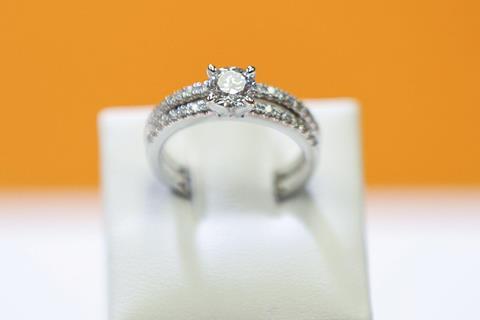
The rarity of diamonds has historically contributed to their appeal, but in the 1950s scientists began a slow-growing revolution that changed the diamond industry forever. Today, diamonds are routinely grown in the laboratory with the majority of these stones having industrial uses, ranging from saw blades to heat spreaders for advanced computer chips to water purification. And increasingly, lab-grown diamonds are also being used as gemstones.
The genuine article
Lab-grown diamonds are the real deal. They are not to be confused with simulant diamonds, such as cubic zirconia. Both diamonds grown in the laboratory and natural diamonds are carbon crystals with a face-centred cubic crystal structure.
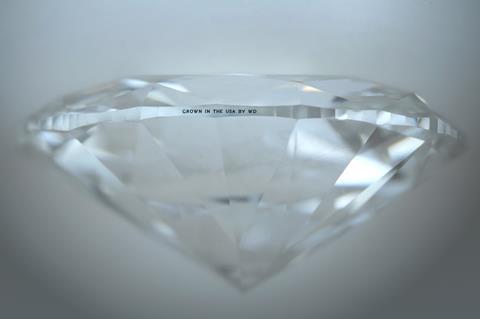
Because their chemical make-up and structure are the same, synthetic diamond gemstones cannot be distinguished from natural diamonds with the naked eye. Lab-grown diamonds for the gemstone industry are therefore laser engraved either on their outer edge or just below their surface. ‘As a consumer, unless you have a microscope to read the laser inscription, you’re not going to know that a diamond is lab-made,’ John Ciraldo, chief technology officer of WD Lab Grown Diamonds in the US.
Analytical instruments can be used to determine a diamond’s origins. These instruments look for slight differences in the trace impurities, which occur due to the different growing environments in nature compared to the lab. ‘For example, nitrogen is found in all diamonds, but differences in heat, pressure and geological timescale held at elevated temperatures result in characteristic differences in the way that the nitrogen incorporates within the natural diamond lattice, which are not reproduced in the lab. This can be readily detected with spectroscopy techniques,’ explains Angelo Frangeskou, technical projects manager at Lightbox, a De Beers Group company that sources its lab-grown diamonds from Element Six, also part of the De Beers Group.
Nature versus nurture
Most diamonds grown in the laboratory do not look how you likely imagine a diamond should. Many are tiny single crystal diamonds, called diamond powder or diamond grit, depending on their size, or polycrystalline diamond wafers instead. The wafers can be grown up to 150mm diameter and are composed of a patchwork of minute intergrown crystals. The technology for growing large single crystal diamonds, such as those used in gemstones, has only really taken off over the past decade.
It was the growing use of diamonds for industrial purposes that led De Beers Industrial Diamonds (now Element Six), General Electric and others to first experiment with growing diamonds in the lab in the 1950s. Before then, all diamonds were natural stones, including those used industrially.
Lab-grown diamonds are not cheap, but they are more affordable than natural ones
Over the decades, the technology has evolved so that diamonds can now be consistently grown in the lab at scale to exacting specifications. For many industrial applications ‘you would have to sort through millions of natural diamonds and you still wouldn’t find one with as good properties as we produce routinely’, says Tim Mollart, principal application engineer at Element Six’s Global Innovation Centre in Harwell, UK.
For a gemstone buyer, cost is a key consideration when choosing a lab-grown diamond. They are not cheap, but they are more affordable than natural diamonds. Environmental concerns associated with mining are also a consideration for some consumers. It should be noted, however, that growing diamonds in the laboratory is still a very energy intensive activity.
Growth matters
Synthetic diamonds are grown in two different ways: the high pressure, high temperature (HPHT) technique, which was developed in the 1950s, and the chemical vapour deposition (CVD) method, which was developed in the 1980s.
HPHT is the method that most closely mimics the processes that occur in nature and it is used to produce large single crystal diamonds, diamond powder and diamond grit. Tiny diamond seeds (a fraction of a millimetre in diameter), graphite (the carbon source) and a molten metal catalyst are placed in a metal capsule approximately the size of a baked bean tin. ‘You put your pre-synthesis and everything in this little can, wrap it in a ceramic blanket and then you put it in your press,’ says Mollart. The press subjects the capsule to temperatures above 1300°C and pressures of around 55,000 atmospheres (5.5GPa). Under these extreme conditions, the graphite dissolves in the molten metal and migrates through it to the cooler diamond seeds, where it crystallises on its surface.
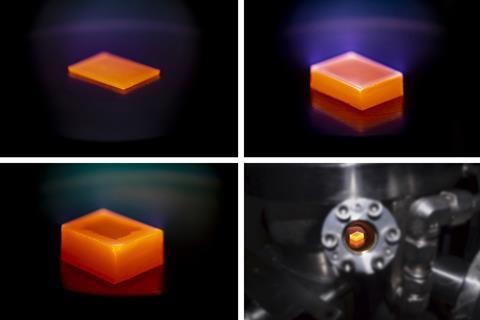
CVD enables diamond growth from plasma containing hydrogen and carbon radicals and is used for producing large single crystal diamonds and polycrystalline diamond wafers. Seeds are placed in a CVD chamber that is evacuated before a gas mixture predominantly containing methane and hydrogen is pumped in. Microwaves then convert the gases into plasma, and methyl radicals deposit on the surface of the seeds to slowly grow the diamond. For single crystal diamonds, the seeds are very thin slivers that provide the footprint for the final diamond. ‘The challenge in CVD diamond is to find the right balance of all the variables, such as temperature, pressure, power and gas chemistry, while also maintaining a good interface between the plasma and the diamond growth surface,’ explains Ciraldo. Polycrystalline diamond wafers meanwhile are grown from minuscule diamond seed crystals sprinkled on a silicon, metal, ceramic or other proprietary surface.
HPHT and CVD take a similar length of time to grow a diamond, taking between minutes and hundreds of hours depending on the size of the crystal being grown. These diamonds are then cut and processed into the desired shapes and sizes for their intended application.
Hard and cool
Diamond is the hardest material on Earth and it was this property that was first to be exploited industrially. Diamond powder and diamond grit have been extensively used for industrial-scale cutting, grinding and polishing for decades. Granite countertops and mobile phone edges are among the many everyday products routinely polished and machined using diamonds today.
Some industrial drill bits also have a polycrystalline diamond outer layer. ‘Diamond replaced tungsten carbide for drilling in the oil and gas industry in the 1990s and the same is beginning to happen in the mining and extraction industries,’ says Mollart. Single-crystal diamonds and polycrystalline diamond wafers are also routinely used today for precision cutting, including as surgical scalpel blades for biopsies and eye surgery.
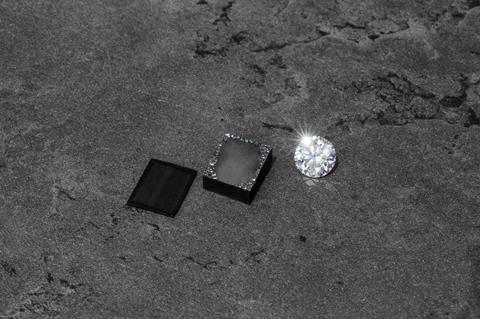
Diamond is also an excellent thermal conductor. Its thermal conductivity at room temperature is over six times that of the best metals. Diamond gemstones are commonly referred to as ice, but it’s a common misconception that this is because they visually resemble ice crystals, explains Ciraldo. ‘In reality it’s because if you hold a handful of diamonds, it feels like you’re holding ice. They pull the heat out of your hands so efficiently that they feel cold to the touch.’
This property is widely exploited by the semiconductor industry as an alternative to ceramics such as aluminium nitride to efficiently cool silicon. For these applications, polycrystalline diamond wafers are normally used as they can be grown much larger and are cheaper than single crystal diamonds, explains Martin Kuball, a physics professor at University of Bristol, UK, and long-time Element Six collaborator. ‘Single-crystal diamond, because it can be made more defect-free, is the best from the thermal conductivity viewpoint. But polycrystalline diamond is actually [a] perfectly fine [heat spreader] for these sorts of materials.’
Diamond is currently being explored as a heat spreader for wide bandgap semiconductors such as gallium nitride. Transistors made from these next-generation semiconductors can be much smaller and have higher power densities than those made from silicon. These next-generation transistors are enabling applications ranging from faster charging of electric cars to rapid download of digital content over the telecoms network. They also have potential impact towards efforts to reduce carbon emissions. For electric vehicles, for example, shifting from silicon to gallium nitride chips would increase both their range and charging speed. Kuball is currently developing transistors in which a polycrystalline diamond layer is grown directly onto a gallium nitride layer in a CVD chamber.
Diamond itself is also being explored as a better semiconductor material than gallium nitride. Diamond is an electrical insulator, but by adding impurities into its lattice it’s possible to perturb its structure and increase the number of free electrons it contains. This doping process has been used for decades to modify silicon’s conductivity. Kuball is particularly interested in using doped diamond’s semiconducting and thermal conductivity properties simultaneously – therefore eliminating the need for a separate heat spreader and semiconductor.
Electrifying diamonds
Boron and nitrogen, which sit either side of carbon in the periodic table, are the obvious candidate impurities for doping diamond, explains Julie MacPherson, an electrochemistry researcher at the University of Warwick, UK, who also collaborates with Element Six. Natural gemstones can contain tiny amounts of both these elements, with nitrogen giving diamond a yellow hue and boron blue. The priceless 45-carat Hope Diamond, originally from India and now in the US National Museum of Natural History in Washington DC, is the most famous example of the latter.
The process only requires one carbon atom in 1000 to be replaced by boron
For semiconductors, boron-doped diamond is used as ‘boron is one electron deficient compared to carbon so you create a p-type semiconductor,’ says Macpherson. Polycrystalline boron-doped diamond is typically produced by adding boron-based gas to the gas mixture pumped into the CVD chamber during the diamond growth process.
If enough boron is added, the polycrystalline diamond ceases to be a semiconductor and becomes a metal-like electrical conductor instead. ‘This process only requires one carbon atom in 1000 to be replaced by boron,’ Macpherson explains. Conducting diamond is black rather than blue, and is widely used as electrodes for electrochemistry sensors. The strength and chemical inertness of diamond is retained when it is doped, meaning it can be used in challenging environments such as nuclear reactors, for long-term environmental monitoring and for sensors that can sit on the skin.
Water electrolysis is another application of boron-doped diamond electrodes. The surface properties of the diamond can be tweaked to control whether the water is oxidised to form ozone or hydroxyl ions. This approach to producing ozone has been around for a decade or so, to disinfect ice machines and fast-food lines, and most recently in consumer disinfectant sprays. US-based ozone technology company Enozo Technologies developed the latter in together with Element Six. The bottle has an electrochemical cell between its water reservoir and its nozzle. ‘When you press the button, you’re switching on an oxidising potential to the anode which is high enough to split water and to give ozone which is dissolved in the water, that will come out as a spray from the bottle,’ says MacPherson. Mollart adds: ‘It’s 2ppm of ozone in water and it makes a fantastic disinfectant.’
Boron-doped diamond electrodes are currently being explored for breaking down so-called ‘forever chemicals’ in drinking water. There is increasing evidence that the presence of low levels of these per- and polyfluoroalkyl substances (PFAS), used to make non-stick and stain resistant products, in drinking water is harmful for human health. Their durability prevents current water treatment methods from destroying them. ‘The US Environmental Protection Agency has said that electrochemical oxidation with diamond is one of the potential solutions,’ says Mollart. For these applications, the diamond surface is engineered to produce hydroxyl radicals that then break down these robust organic pollutants.
A diamond is forever
Although synthetic diamonds have been grown for industrial use for decades, the idea of growing diamond gemstones didn’t take off until relatively recently. Lab-grown diamond gemstones ‘have been around for quite a while, but in 2015 you really begin to see that they are being manufactured at scale, so this felt like the tipping point between a niche product to something that was becoming a ubiquitous, mainstream jewelry product’, says Frangeskou.
Diamond gemstones are grown using both HPHT and CVD techniques. To remove any residual unwanted hints of colour that might remain from the growth process, some CVD-grown diamonds are then placed in an HPHT press post-growth to anneal and remove any defects that might impact the colour.
The process of growing diamonds is neither easy nor quick
There are two ways to create blue diamond gemstones. They can be doped with boron, using the same approach as use for the semiconductor and electrochemical industries. Or trace amounts of vacancies can be introduced into the diamond lattice post-growth by bombarding it with high energy sub-atomic particles. To create pink diamonds both nitrogen doping and post-growth annealing and irradiation are needed.
Regardless of their type, size and colour, the process of growing diamonds is neither easy nor quick. This is why lab-grown diamonds are not cheap commodities. Kuball, however, is keen to emphasise that for industrial applications, synthetic diamonds – and especially polycrystalline diamond wafers – are not as expensive people tend to think they are. Macpherson agrees, saying that ‘a lot of people don’t realise you can grow it on a large scale, and cut out lots and lots of tiny electrodes from that large wafer’. Mollart adds that ‘the cost of ownership can be [also be] quite low’. By this he means that since diamonds are so durable, they typically can be used for longer than their less hardy competitors.
To change this pricing misconception for synthetic diamonds, maybe some advertising brilliance akin to the ‘a diamond is forever’ slogan is needed. After all, this tagline that has been used by De Beers continuously since 1948 is widely credited with revolutionising the natural diamond industry and propelling diamonds to a status far higher than any other type of gemstone.
Nina Notman is a science writer based in Salisbury, UK
With thanks to Tim Mollart, Daniel Twitchen and Gabriella Sciarrone for the tour of the Element Six Global Innovation Centre in Didcot, UK
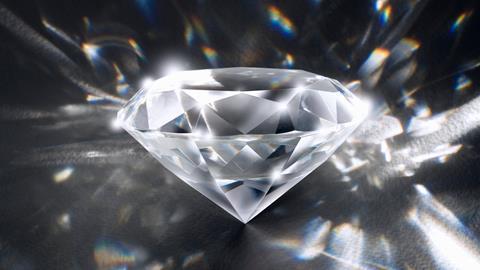

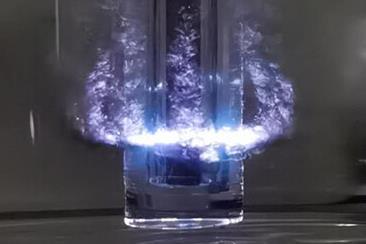
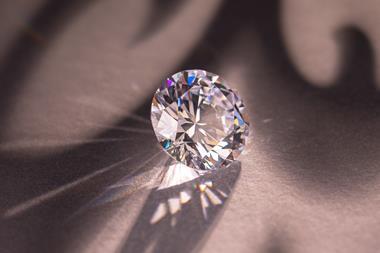
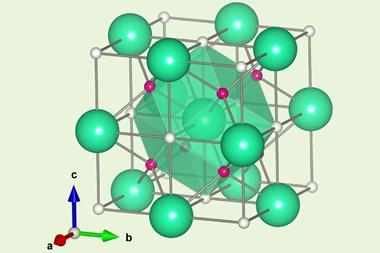
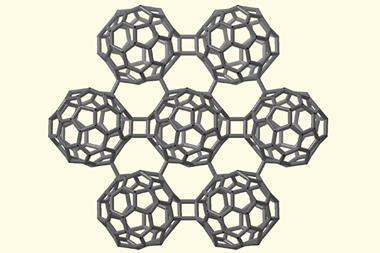
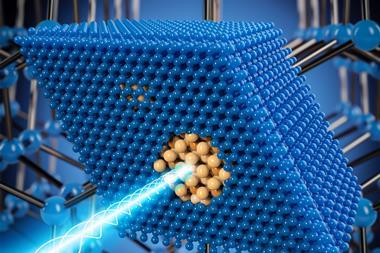






No comments yet